 |
|
Renovation from A1/A4 to Champion Bermudagrass, Part 2...
Steven Harris, CGCS, Brier Creek Country Club, Raleigh, NC:
 "Wednesday June 27th, the day before planting... Wednesday was the last day we had to finish all of the prep work before Champion came to plant the greens. We had a lot of work to do before the day ended. We still had to finish dragging in the sand from aerification, fill in the area that we sod cut with greensmix sand and we still had to apply all of the amendments and fertilizers.
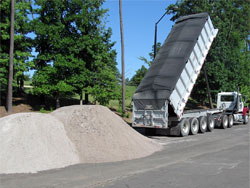
|
Filling the edges was all hand work. Our staff is amazing! They filled it all in in only a couple of hours just in time for us to start getting the fertilizer and amendments on the greens.
In order to fill in all the edges and then have enough sand to topdress the sprigs on Thursday, we ordered eight truckloads of greensmix sand. The greensmix is a blend of 80% BB202 sand and 20% Sphagnum Peat Moss. Eight truckloads is approximately 192 tons of sand. We staged this sand in the lower parking lot of the swim-tennis parking lot.
After all of the edges were backfilled, we had to get all of the fertilizer amendments out on the greens. These amendments are a mixture of raw nutrient and mineral and fertilizers. The amendments will provide nutrition for the new sprigs and help establish them quicker and healthier. Our pre-plant consisted of calcitic limestone, manganese, K-Mag, Diammonium Phosphate, two different organic fertilizers, a micro nutrient package and an 18-0-18 fertilizer. All in all it was 34,200 pounds of fertilizer that must be applied prior to planting.
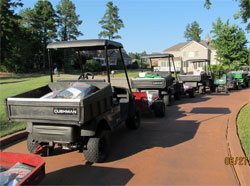 | 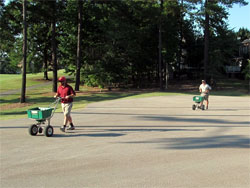 |
By the end of the day Wednesday, we were far enough ahead that we could finish the rest of the greens while the Champion crew started sprigging on Thursday. Thursday the crew from Champion Turf Farms would be at Brier Creek to begin spreading sprigs of Champion bermudagrass.
Thursday June 28th and Friday June 29th: Planting Day... Thursday morning came and so did the tractor trailer full of Champion bermudagrass... all the way from Bay City TX in a truck refrigerated to 38 degrees. Soon after, the crew from Champion Turf Farms arrived to begin planting the greens. The crew consisted of six guys who would spread the bushels of sprigs across the greens. Each green takes 20-40 minutes on average.

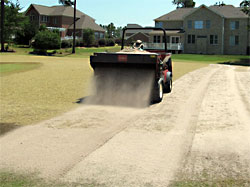
|
After the greens are sprigged, we follow with a thick layer of the 80/20 greensmix. Once the greens are topdressed and the sprigs are mostly covered, the water is turned on and the green is finished. The crew took all day Thursday and half of the day Friday.
Champion Turf Farm was pleasure to work with... one of the best I have dealt with in my career. On Tuesday the owner of the company, Mike Brown, stopped by to see how the prep work was going. They were true professionals.
For the next seven days or so, we will be watering hourly so that the sprigs do not dry out. The high temperatures we have been having are good for the sprigs as long as they stay wet.
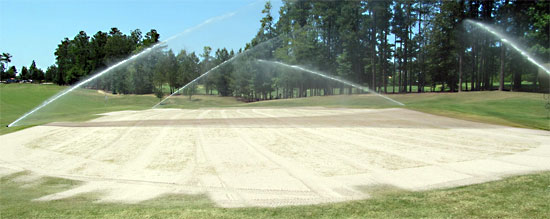
Where do we go from here? After about seven days we will see some green leaves emerging from the sprigs. The sprigs will then start to send stolons down to anchor the plants to the ground. After 12 days we will roll the greens to start smoothing them out. After 14 days, there is a good possibility that we will be ready for our first mowing! The greens should be almost completely covered over in 3-4 weeks."
We'll have still more from Brier Creek next week. In a hurry? Visit Steven's blog at briercreekgcmaintenance.blogspot.com.
|
 |
|
Greens Survival During The Heat/Drought
Jim Flett, Muskoka Lakes Golf & Country Club, Muskoka, Ontario:
 "It's been almost two months since we have received a significant rainfall. The course is holding up pretty well considering the conditions but would certainly benefit from a steady all day rain.
Being an older property, our course contains a significant amount of POA ANNUA which is a winter annual that germinates in late summer/early fall once soil temperatures have dropped below 70°F. Seedlings mature in the fall, overwinter in the vegetative state, and produce seed in late spring and early summer. Some germination of annual bluegrass seed also occurs in the spring. The seed may lie dormant in the soil for many years before germinating resulting in a significant build-up of indigenous seed overtime. Poa annua is one of the five most widely distributed plants in the world.
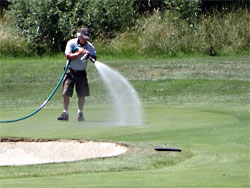 Poa annua is more prolific and competitive under with conditions of close mowing, light frequent irrigation, high fertility, and moist/compacted soils. It tends to be more prolific during wet seasons which we've had our share over the years. Unfortunately Poa annua often dies in the heat of the summer due to heat and drought stress, disease, and/or insect damage.
Fortunately due to practices implemented over the years, our course contains a fairly high percentage of creeping bentgrass on most green surfaces that is a lot more tolerant of these heat and drought conditions. This fact gives our turf a higher level of reliability and will help us weather the storm of this recent heat wave/drought. Our greens are not entirely free of thin turf areas, but are standing up pretty well to the prolonged weather conditions.
Other measures to reduce stress to grasses during this drought/heat period include:
- Monitoring moisture conditions using moisture meters and hand watering to ensure appropriate irrigation is applied (not too dry or too wet).
- Raising of mowing heights to moderate levels.
- Varying foot traffic to reduce concentrated wear and tear on turf.
- Use of soil wetting agents to help water penetrate and retain moisture.
- Application of foliar fertilizers to give the turf plants the nutrients they need to combat turf stress.
- Not mowing greens and skipping a mow day on occasion and roll only to give the turf a break."
Visit Jim's blog at mlgccgreens.blogspot.ca
|
 |
|
Lights, Camera, Action
Joel Purpur, Park Ridge Country Club, Park Ridge, IL:
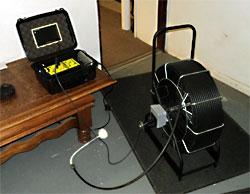
Camera and cable on the right and screen and recorder on the left.
|
 "One of our new tools this year is a sewer inspection camera. This device consists of a camera with lights attached to a rather long cable which is connected to a small screen and digital recording device. The camera can be fed into drainage lines to visually inspect them for defects or tree roots.
On Tuesday we had to opportunity to try it out on the catch basin in front of #10 and fed it upstream towards #9 green. Take a look at what we found: roots."
Visit Joel's blog at parkridgeccgrounds.blogspot.com.
|
 |
|
A Quick Healer
John Slade, Laurel Creek Country Club, Mt. Laurel, NJ:
 "Not to beat the subject to death, but take a look at how fast the new Bermudagrass on the lower practice tee fills in. The picture on top was taken the day after the divots were created, and the picture below is the same area just 14 days later. The only thing we have to do with the Bermudagrass tee is to fill in the divots with a sand mix, and level off the area.
In contrast to this, the turf on the upper tee takes a whole lot more work to maintain. The divot mix used up top includes: sand mix, pennmulch, fertilizer, seed, and dye. All of these ingredients are carefully measured and put into a cement mixer. If that wasn't enough, we also use a tractor-mounted seeder on the upper tee weekly, and have been hand-watering it daily to encourage seed germination.
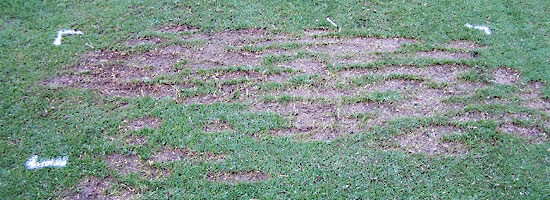
Above: The fresh divots. Below: 14 days later.
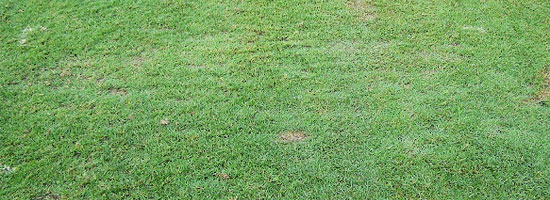
|
In a tough summer like this, it's nice to have a small piece of the course that is relatively easy to maintain."
Visit John's blog at laurelcreeksuper.blogspot.com.
|
 |
|
Trees Marked for Removal
Greig Barker, Highland Country Club, London, Ontario:
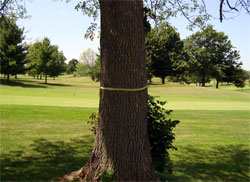 "As you play the golf course over the next week, you will notice a dozen or so trees marked with yellow marking tape. These are trees that we will be removing during the course closure scheduled for next Tues/Wed. All but one of the marked trees are Ash trees that have been affected by the Emerald Ash Borer. The majority of the trees are located to the left side of #15 green by the path.
If you happen to see the trees that are marked, take a second to examine the entire tree, you will notice significant decline in the canopy with a large number of dead or dying branches. These trees are becoming unsafe and unsightly. Our goal is to have the trees removed, stumped and cleaned up in a quick manner during course closure."
Visit Greig's blog at highlandccgroundsdept.blogspot.ca.
|
 |
|
Mottled Fairway Look, LDS, Fairy Ring and Lack of Rain
Joe Wachter, CGCS, Glen Echo Country Club, St. Louis, MO:
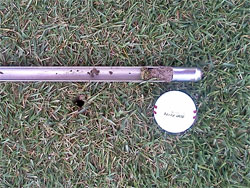
The probe was only able to pull out a two" deep plug from the LDS spot on #10 fairway. Only about 1" of the plug had a fair amount of moisture.
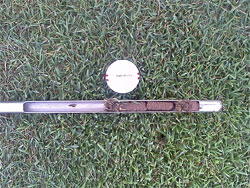
Just 6" away, the area to the right of the spot above, the probe was able to penetrate 6" with moisture throughout the plug.
|
 "Our fairways have taken on a mottled look in various areas based on lack of rainfall and other factors over the past two months. One of the biggest factors is a condition called Localized Dry Spots or LDS. Basically, its an area of soil or sand that repels water or does not accept water as readily as other spots in a nearby surrounding area. The pictures below show the difficulty in managing this problem. We've sprayed a soil penetrant on our fairways to improve the soils ability to absorb moisture.
Other factors which lead to LDS include fairy ring, sodium or bicarbonate build up from our city irrigation water, and irrigation coverage. Also, in an effort to keep our soaring water bill costs reduced as well as being environmentally responsible, water has been applied in judicious amounts.
As temperatures begin to moderate and more normal rainfall occurs, I believe you will see improvements in the overall look of the fairways.
In the meantime, enjoy the long ball roll!"
Visit Joe's blog at geccgcm.blogspot.com.
|
 |
|
About our Blog Aggregator: Many superintendents are now hosting private blogs to better communicate with their golfers and/or members. Beyond local weather and course conditions, there is a great deal of information about projects, methodologies and techniques that would be of value to other superintendents — hence our Turf Blog Aggregator. As every blogger struggles occasionally with content, we also include posts intended to educate golfers about turf maintenance for others to use as a template for their own blogs.
Miss any previous issues of TBA? You can find them all here.
Turf Blog Aggregator(TM) is a trademark of Turnstile Media Group.
|
|